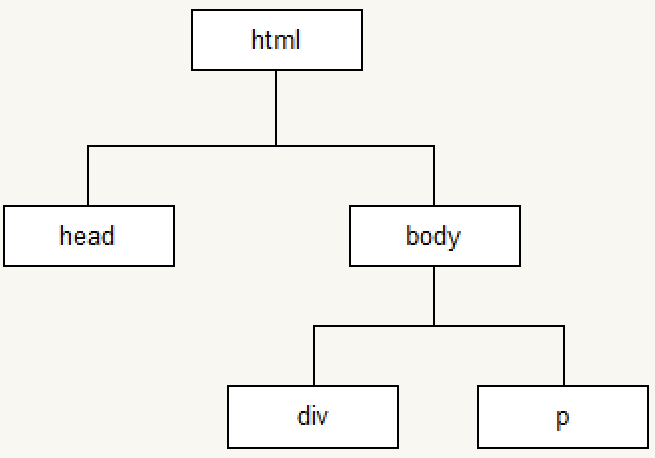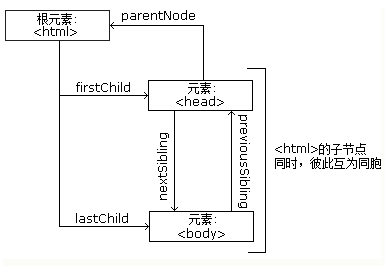[TOC]
# children和childNodes
**1,childNodes 屬性**,標準的,它返回指定元素的子元素集合,包括HTML節點,所有屬性,文本。可以通過nodeType來判斷是哪種類型的節點,只有當nodeType==1時才是元素節點,2是屬性節點,3是文本節點。
有些人錯誤的使用()去取該集合元素,下表列出各瀏覽器對childNodes(i)的支持情況:
**2,children 屬性**,非標準的,它返回指定元素的子元素集合。經測試,它只返回HTML節點,甚至不返回文本節點。且在所有瀏覽器下表現驚人的一致。和childNodes 一樣,在Firefox下不支持()取集合元素。因此如果想獲取指定元素的第一個HTML節點,可以使用children\[0\]來替代上面的getFirst函數。需注意children在IE中包含注釋節點。
# 節點操作
~~~
var body = document.body;
var div = document.createElement('div');
body.appendChild(div);
var firstEle = body.children[0];
body.insertBefore(div, firstEle);
body.removeChild(firstEle);
var text = document.createElement('p');
body.replaceChild(text, div);
~~~
# 節點屬性
* nodeType 節點的類型
* 1 元素節點
* 2 屬性節點
* 3 文本節點
* nodeName 節點的名稱(標簽名稱)
* nodeValue 節點值
* 元素節點的nodeValue始終是null
## 模擬文檔樹結構


## 節點層級
重點講父子屬性,兄弟屬性畫圖講解
~~~
var box = document.getElementById('box');
console.log(box.parentNode);
console.log(box.childNodes);
console.log(box.children);
console.log(box.nextSibling);
console.log(box.previousSibling);
console.log(box.firstChild);
console.log(box.lastChild);
~~~
* 注意
childNodes和children的區別,childNodes獲取的是子節點,children獲取的是子元素
nextSibling和previousSibling獲取的是節點,獲取元素對應的屬性是nextElementSibling和previousElementSibling獲取的是元素
? nextElementSibling和previousElementSibling有兼容性問題,IE9以后才支持
* 總結
~~~
節點操作,方法
appendChild()
insertBefore()
removeChild()
replaceChild()
節點層次,屬性
parentNode
childNodes
children
nextSibling/previousSibling 兄弟節點
nextElementSibling 兄弟元素
firstChild/lastChild
~~~
# 元素和節點的區別
~~~
<a>abc</a>
~~~
元素(Element)是節點(Node)的一種
`<a>`是個元素,也是一個節點
abc不是元素,是文本節點
# 獲取首元素,兼容性
在火狐上有一些不支持, 可以用下面的辦法
~~~
<div id="box">
<div>這是一個廣告圖片</div>
<ul>
<li>這是一個列表</li>
</ul>
<span>說明性文字</span>
</div>
<script>
// box.firstChild 獲取第一個子節點
// box.firstElementChild 獲取第一個子元素, 有兼容性問題,從IE9以后支持
//
// box.lastChild 獲取最后一個子節點
// box.lastElementChild 獲取最后一個子元素, 有兼容性問題,從IE9以后支持
var box = document.getElementById('box');
// console.log(box.firstChild);
// console.log(box.firstElementChild);
var ele = getFirstElementChild(box);
console.log(ele);
// 處理瀏覽器兼容性
function getFirstElementChild(element) {
var node, nodes = element.childNodes, i = 0;
while (node = nodes[i++]) {
if (node.nodeType === 1) {
return node;
}
}
return null;
}
</script>
~~~
# 代碼
## 文檔樹
~~~
<div id="box">hello</div>
<p id="p">world</p>
<!-- 這是注釋 -->
<script>
var box = document.getElementById('box');
console.dir(box);
// 創建一些列具有相同屬性的對象,構造函數
// 獲取對象沒有的屬性,屬性的值是undefined
function Node(options) {
// 設置屬性的默認值
this.className = options.className || '';
this.id = options.id || '';
// 跟節點相關的屬性
// 節點的名稱,如果是元素的節點的話,是標簽的名稱
this.nodeName = options.nodeName || '';
// 節點的類型 如果是元素節點 1 屬性節點 2 文本節點 3 數值類型
this.nodeType = options.nodeType || 1;
// 記錄節點的值,如果是元素節點,始終是null
this.nodeValue = options.nodeValue || null;
// 記錄子節點
this.children = options.children || [];
}
// 創建html節點
var html = new Node({
nodeName: 'html'
});
// 創建head節點
var head = new Node({
nodeName: 'head'
});
// 設置html中的子節點 head
html.children.push(head);
// console.dir(html)
// body
var body = new Node({
nodeName: 'body'
})
// 設置html中的子節點 body
html.children.push(body);
// div
var div = new Node({
nodeName: 'div'
})
// p
var p = new Node({
nodeName: 'p'
})
// 設置body的子節點
body.children.push(div);
body.children.push(p);
console.dir(html);
</script>
~~~
## 父子節點和元素
~~~
<div id="box">
<span>span</span>
<p>p標簽</p>
<!-- 這里是注釋 -->
</div>
<script>
var box = document.getElementById('box');
console.dir(box)
// 節點的層次結構
// 父子結構
// parentNode 父節點 只有一個
// childNodes 子節點 有很多個
// children 子元素
var box = document.getElementById('box');
console.log(box.parentNode);
console.log(box.childNodes);
// 屬性節點、元素節點、文本節點、注釋節點
for (var i = 0; i < box.childNodes.length; i++) {
// 找到box中所有的子元素
var node = box.childNodes[i];
// 判斷當前的子節點是否是元素節點
if (node.nodeType === 1) {
console.log(node);
}
}
//
//
// 有沒有能夠直接獲取子元素的屬性? children
var box = document.getElementById('box');
console.log(box.children); // 所有的子元素
</script>
~~~
- HTML
- 標簽
- 超鏈接
- 列表
- 表格和表單
- h5新增標簽
- 快捷方式
- 標簽包含
- CSS
- 選擇器
- 行內,塊元素,鏈接
- css三大特性
- 盒子模型
- 定位
- css可見性
- emment書寫
- 文本元素
- 外觀屬性
- 背景
- 浮動
- ps
- 用戶界面樣式
- 顯示和隱藏
- 過渡
- 2D,3D變形
- 動畫animation
- 伸縮布局(CSS3)
- BFC
- 優雅降級和漸進增強
- 3D旋轉
- 雙飛翼和圣杯
- JS基礎
- 輸出消息的幾種方式
- 數據類型
- Date對象
- Math對象
- Array對象
- 字符串常用方法
- 數據類型轉換
- 等號運算
- 代碼調試
- 數組
- 函數
- WebAPI
- webapi簡介
- 獲取頁面元素
- 事件
- 屬性操作
- 創建元素
- 節點操作
- 事件詳解
- BOM
- 位置相關屬性
- 拖拽彈窗
- 彈出層加遮罩
- ES6
- let和const
- 解構表達式變化
- 函數優化
- map和reduce
- nrm
- npm
- npm基礎
- package.json
- 淘寶鏡像
- webpack
- 介紹
- 多入口文件(Multiple entry files)
- Webpack CSS loader加載器
- webpack Image loader 加載圖片
- uglify-js壓縮打包JS
- webpack構建本地服務器
- vue內部指令
- v-if,v-show,v-for
- v-text,v-html
- v-on
- v-model
- v-bind
- v-pre,v-cloak,v-once
- vue全局api
- Vue.directive 自定義指令
- vue.extend構造器的延伸
- vue.set全局操作
- Vue的生命周期(鉤子函數)
- Template 制作模版
- Component 初識組件
- Component 組件props 屬性設置
- Component 父子組件關系
- Component 標簽
- vue選項
- propsData Option全局擴展數據傳遞
- computed Option 計算選項
- Methods Option 方法選項
- watch選項監控數據
- Mixins 混入選項操作
- Extends Option 擴展選項
- delimiters 選項
- vue實例和內置組件
- 實例屬性
- 實例方法
- 實例事件
- 內置組件 -slot
- vue-cli
- vue-cli介紹
- 項目目錄結構
- vue-cli模板
- vue-router
- 簡介
- 配置子路由
- 參數傳遞
- 單頁面多路由區域操作
- url傳遞參數
- vscode
